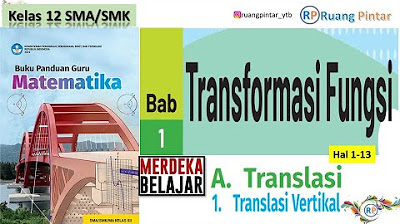CONTOH SOAL DAN PEMBAHASAN TRANSFORMASI LINEAR
Summary
TLDRIn this educational video, the speaker explains the concept of linear transformation using a mathematical example. The focus is on verifying whether a given function, which maps vector spaces, satisfies the conditions of a linear transformation. The conditions discussed are additivity and homogeneity. Through a detailed example, the speaker demonstrates how to check these properties step by step, concluding that the given function is indeed a linear transformation. The video aims to help viewers understand these core concepts in linear algebra.
Takeaways
- 😀 The speaker introduces themselves and the topic of linear transformations in the context of vector spaces.
- 😀 The script explains the basic definition of a linear transformation, which maps a vector space V to a vector space W.
- 😀 A linear transformation must satisfy two key conditions: additivity (F(u + v) = F(u) + F(v)) and homogeneity (F(k * u) = k * F(u)) where k is a scalar.
- 😀 The speaker highlights the importance of understanding these conditions before solving a linear transformation problem.
- 😀 The script provides a step-by-step explanation of solving a problem to check if a given function is a linear transformation.
- 😀 The example problem involves checking if the function F(x, y) = 3x + y - x - y defines a linear transformation from R^2 to R^2.
- 😀 The first condition (additivity) is verified by testing the sum of vectors (u + v) and comparing it with F(u) + F(v).
- 😀 The second condition (homogeneity) is checked by multiplying a scalar k with a vector u and ensuring the result matches k * F(u).
- 😀 The speaker demonstrates the algebraic steps of solving the example problem, including substitution into the function and simplification.
- 😀 After verifying both conditions, the speaker concludes that the function is indeed a linear transformation, as it satisfies both conditions.
Q & A
What is the main topic discussed in the video script?
-The main topic of the video is linear transformations in vector spaces, including an explanation of the definition and properties of linear transformations, followed by an example problem.
What is a linear transformation, according to the script?
-A linear transformation is a function that maps a vector space V into another vector space W, satisfying two main properties: additivity (F(u + v) = F(u) + F(v)) and homogeneity (F(k * u) = k * F(u)), where u and v are vectors and k is a scalar.
What is the first condition a function must satisfy to be considered a linear transformation?
-The first condition is additivity, meaning that F(u + v) must equal F(u) + F(v), where u and v are vectors in the vector space.
What is the second condition for a function to be classified as a linear transformation?
-The second condition is homogeneity, which means that F(k * u) must equal k * F(u), where k is a scalar and u is a vector.
How does the script demonstrate whether the given function is a linear transformation?
-The script demonstrates it by testing the two conditions of linearity. It checks if additivity and homogeneity hold for the given function F(x, y) = (3x + y, x - y) through a series of calculations involving vector addition and scalar multiplication.
What was the function given in the example problem?
-The function given in the example problem is F(x, y) = (3x + y, x - y), where x and y are components of the input vector.
How does the script handle the verification of the additivity condition?
-The additivity condition is verified by considering two vectors, u = (x1, y1) and v = (x2, y2), and checking if F(u + v) equals F(u) + F(v). The script performs the necessary substitutions and calculations to show that the condition holds.
How does the script verify the homogeneity condition?
-The homogeneity condition is verified by testing if F(k * u) equals k * F(u) for a scalar k. The script directly substitutes and calculates to show that the condition holds true.
What conclusion is drawn at the end of the video?
-The conclusion is that the given function is indeed a linear transformation, as it satisfies both the additivity and homogeneity conditions.
What is the significance of the phrase 'Assalamualaikum warahmatullahi wabarakatuh' in the context of the video?
-'Assalamualaikum warahmatullahi wabarakatuh' is a common Islamic greeting, which is used to begin and end the explanation as a sign of respect and courtesy in the context of the video.
Outlines

This section is available to paid users only. Please upgrade to access this part.
Upgrade NowMindmap

This section is available to paid users only. Please upgrade to access this part.
Upgrade NowKeywords

This section is available to paid users only. Please upgrade to access this part.
Upgrade NowHighlights

This section is available to paid users only. Please upgrade to access this part.
Upgrade NowTranscripts

This section is available to paid users only. Please upgrade to access this part.
Upgrade NowBrowse More Related Video

Translasi Vertikal Hal 1-13 Bab 1 TRANSFORMASI FUNGSI Kelas 12 SMA SMK Kurikulum Merdeka

Matematika Kelas 9 Bab 1 Sistem Persamaan Linear Dua Variabel - hal. 2 - 6 - Kurikulum Merdeka

Metode Numerik Pertemuan Regresi Linier

Matrices for General Linear Transformations | Linear Algebra

Menyelesaikan Permasalahan Program Linear Menentukan Nilai Optimum dengan Metode Uji Titik Pojok

Sistem Persamaan Linear Tiga Variabel (SPLTV) membuat model matematika | by Iga Apriliana Mahardika
5.0 / 5 (0 votes)